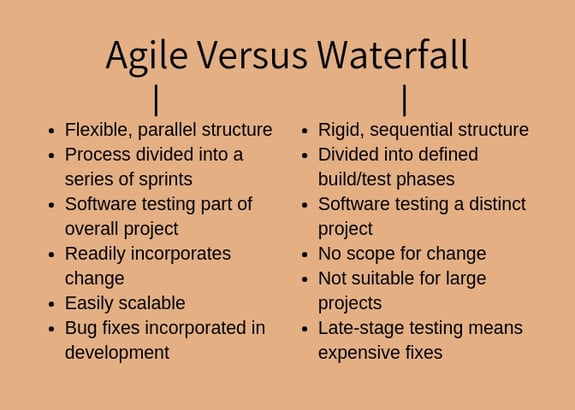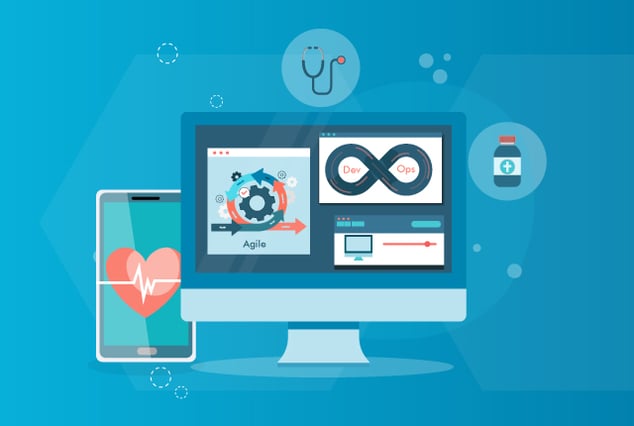
Agile teams produce better products because they see the bigger picture. Involving those with a business perspective along with your technical team during the software testing process helps maintain focus on where all the hard work is headed.
Adding an expert QA team to that mix only improves matters. Now, you have a diverse range of skill sets, experience, and perspective to round out your product offering.
Bringing cross-functional teams together promotes efficiencies that ultimately lead to better products and a sturdier, more reliable user experience.
The Agile method can dramatically boost productivity, but it does require a shift in the way we work. We have put together several tips to help you make the transition and maximize the benefits of using Agile teams.
The Agile Advantage for Software Testing
The Agile approach to software testing has become the dominant method for achieving success in larger projects. It is the preferred choice of market leaders like Microsoft and Oracle because it makes it easier to meet deadlines, reduces documentation time, and maximizes release cycle time.
You can see the potential advantages when the Agile method is laid out against traditional waterfall conventions:

You can maximize your Agile team and realize those potential benefits with the following tips.
Include Your QA Team from the Start
Your QA team should be present at the earliest planning and requirements analysis meetings, so they gain a foundational understanding of the project goals and your expectations. In fact, every member of your Agile team, regardless of their primary expertise, should have a chance to voice their opinions and ideas as early as possible. This helps open communication lines and encourages people to take responsibility for the product.
Prioritize Effective Communication
Clear lines of communication are the lifeblood of Agile teams. You must ensure product managers, scrum masters, engineers, and your QA team are empowered to exchange ideas, problems, and workflows. That means embracing every communication advantage available, from email to video conferencing.
To aid these links, establish a regular routine of meetings, include as many cross-functional team members as is practical, and create the opportunity to readily escalate challenges to senior management.
Promote Equality in an Agile World
Every member of your Agile team works in parallel during your software testing process, and everyone’s role is of equal importance. Establishing shared responsibility for the project will encourage the dissemination of information and easier exchange of challenges and solutions.
Expert overlap and cross-team communication are the foundation of Agile success. You need to encourage as much cross-functional interaction as possible.
Build Your Process Around Your Team
The testing tools, technologies, and frameworks available to you will depend on the specifics of your project. The final choice, however, should be heavily influenced by the preferences and skills of your Agile team. Engineers and QA testers will always have preferred tools. For example, using a more user-friendly framework that is keyword-driven or behavior-driven decreases the need for technical knowledge and expands your testing talent pool.
Take Advantage of Offshore Solutions
The rapid adoption of video conferencing means there is little difference between staging a meeting with a QA team that is located next door or one that is half a world away. Removing the tyranny of distance opens up the resource advantages of offshore QA testing within an Agile environment.
Labor savings alone can reduce your QA spend by half, and the time difference between the U.S. and locations such as India and Southeast Asia allows you to develop a 24-hour work cycle with your Dev teams picking up where your external testers leave off on any given day.
Minimize Risk
Every time a new feature is planned or a serious error necessitates change, there are repercussions across the project. Agile teams are better able to perform risk analysis and assess whether it is worth pursuing in reference to a range of stakeholders, from business analysts to user interface testers.
And your QA team encompasses more than just testers. They have diverse skill sets and years of experience that should be used to your advantage across your software testing process.
The list above is far from exhaustive. If you want to delve deeper into Agile team strategies, consider our whitepaper 7 Best Practices for Successful Offshore Agile QA or our webinar The Three Pillars Approach to Your Agile Testing Strategy. Both sources offer expert insights for transitioning to and maximizing the Agile testing method.
Improved Software Testing Process
Software testing process is refined every time with the implementation of feedback from previous sprint retrospection. This helps to bring efficiency in overall development, early resolution of problems, and faster testing of features in defined timelines.
An Agile Software Testing Process Edge
An Agile software testing process breaks down the silos that have traditionally kept our product experts isolated. By combining the talents of your business, engineering, development, IT, and QA teams, you uncover efficiencies that lead to better products.
This transition requires communication, cross-functional integration, and a steady hand to manage. But, ultimately, Agile teams deliver better user experiences.
QASource has the experience and expertise you need to quickly ramp up your software testing process within an Agile environment. Our engineers collectively have more than 1,000 years of experience working to integrate a world-class QA process within your broader project. Contact us today for a free quote, or call +1.925.271.5555 to get started.


